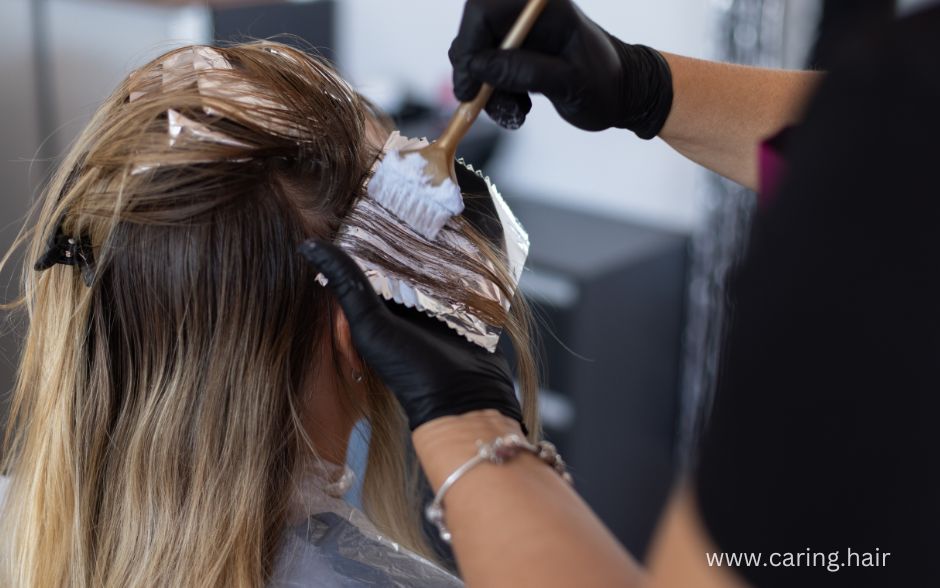Hair coloring is a popular beauty trend that has been around for centuries. From ancient Egypt to modern times, people have been using various methods to change the color of their hair. However, there is a common belief that coloring your hair causes damage, and many people are hesitant to try it because of this myth. In this article, we’ll explore whether this myth is true or not and provide some insights into how hair coloring works.
How does hair coloring work?

Hair coloring is a popular cosmetic treatment that involves changing the natural color of hair. The science behind hair color involves the role of melanin, which is the pigment that gives hair its natural color.
There are two types of melanin: eumelanin, which produces brown or black hair, and pheomelanin, which produces red or blonde hair. Hair dye works by chemically altering the natural pigment of the hair.
Permanent hair color contains chemicals that penetrate the hair shaft and permanently change the color of the hair. Semi-permanent hair color, on the other hand, contains less harsh chemicals that coat the hair shaft and gradually fade over time.
The difference between permanent and semi-permanent hair color lies in the length of time the color lasts and how deeply it penetrates the hair shaft. Overall, hair coloring can be a fun and creative way to express oneself, but it is important to understand the science behind it and choose a safe and appropriate hair dye product.
Myth: Coloring your hair causes damage
There is a common myth that coloring your hair causes damage. This myth suggests that hair dye products weaken the hair shaft, cause breakage, and make the hair more prone to split ends and other forms of damage.
The myth likely originated from the fact that some hair dyes contain harsh chemicals such as ammonia and hydrogen peroxide that can cause dryness and breakage if not used properly.
However, with advancements in hair dye technology, there are now many safe and gentle hair dye products that do not cause significant damage to the hair. In fact, some hair dye products contain conditioning agents that can actually improve the overall health and appearance of the hair. While excessive or improper use of hair dye can potentially cause damage, when used correctly and in moderation, hair dye is generally safe and does not cause significant harm to the hair.
How to minimize hair damage due to hair coloring?
Hair coloring is a popular way to change up one’s look and express oneself, but it can potentially cause damage to the hair if not done properly. To minimize hair damage due to hair coloring, there are several steps one can take.
First, it is important to choose a hair dye product that is gentle and free of harsh chemicals such as ammonia and peroxide. It is also important to follow the instructions carefully and not leave the hair dye on for longer than recommended.
Additionally, using a deep conditioning treatment before and after coloring can help to nourish and strengthen the hair. Regular trims can also help to remove any damaged ends and prevent further breakage. To protect the hair from further damage, it is important to avoid excessive heat styling and to use a heat protectant spray when using hot tools.
Lastly, it is important to maintain a healthy diet and stay hydrated to promote overall hair health. By taking these steps, one can enjoy the benefits of hair coloring while minimizing the risk of hair damage.
How to care for colored hair
- Use a sulfate-free shampoo and conditioner to prevent color fading.
- Wait at least 48 hours after coloring before washing your hair.
- Avoid using hot water when washing your hair, as it can strip the hair of its natural oils and cause the color to fade faster.
- Use a deep conditioning treatment once a week to keep hair hydrated and healthy.
- Protect your hair from the sun and other environmental factors by wearing a hat or using a UV protection spray.
- Avoid using heat styling tools as much as possible, as they can cause damage and fade color faster.
- Use a wide-tooth comb or brush when detangling your hair to prevent breakage.
- Trim your hair regularly to remove split ends and keep it looking healthy.
- Avoid using products that contain alcohol, as they can dry out and damage colored hair.
- Consider using a color-safe leave-in conditioner or serum to help maintain the vibrancy of your hair color.
Can I color my hair at home?
Yes, you can color your hair at home, but it’s important to follow the instructions carefully and use the right products.
Can I color my hair if it’s already damaged?
It’s best to avoid coloring hair that is already damaged. It’s important to repair the hair first before coloring it.
How often should I color my hair?
It depends on the type of hair color and how quickly your hair grows. Generally, permanent hair color can be touched up every 4-6 weeks.
Can I color my hair while pregnant?
It’s best to avoid coloring your hair during the first trimester of pregnancy. After that, it’s generally considered safe, but it’s always best to check with your doctor first.
Can I color my hair if I have allergies?
It’s important to do a patch test before coloring your hair if you have allergies. If you have a reaction, it’s best to avoid coloring your hair.
![Myth: Coloring Your Hair Causes Damage [Debunked] Myth Coloring Your Hair Causes Damage](https://haircarer.com/wp-content/uploads/2023/04/Myth-Coloring-Your-Hair-Causes-Damage.jpg)